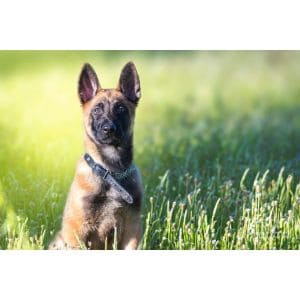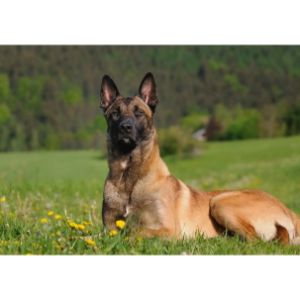
Dogs are known as man’s best friends for a reason. They are loyal, loving, and always happy to see their humans come home. But what about Belgian Malinois?
The ultimate working dog, the Belgian Malinois is energetic, athletic, and generally healthy. The Belgian Malinois is a generally healthy dog with a lifespan of 10 to 14 years.
What affects a dog’s lifespan and what kind of conditions might take one of these remarkable dogs down? In this blog post, we’ll look at the lifespan of the Belgian Malinois, what factors affect it, and the health conditions that they are prone to.
Other articles you would like: What Is A Maltipoos Lifespan? and What Is A Bernedoodle’s Lifespan?
Table of Contents
What Factors Affect The Lifespan Of A Belgian Malinois?

We love our dogs and want them to spend as much time with us as possible. What factors affect a dog’s lifespan and how can you help your Malinois live longer?
Genetics
One thing you can’t help is genes. As any dog owner knows, each breed of dog has its own lifespan.
For example, toy breeds like Chihuahuas typically live for around 15 years, while larger breeds like Labrador Retrievers usually only live for 10-12 years. But why is this? The answer lies in genetics.
Dog breeds have different lifespans due to the genes they inherit from their parents. For example, short-faced breeds like Bulldogs tend to have shorter lifespans because they are more prone to respiratory problems.
Similarly, small breeds like Yorkshire Terriers tend to live longer than large breeds because they are less likely to suffer from joint problems. Of course, there are always exceptions to the rule, but in general, a dog’s lifespan is determined by its genes.
Diet
You are what you eat, and this rings true for dogs as well as us humans. A dog’s diet can have a profound effect on its lifespan. Dogs that are fed a balanced, nutritious diet will live longer and be healthier than those that are not.
One of the most important nutrients for dogs is protein. Protein provides the building blocks for muscle, bone, and tissue growth. It also helps to keep the immune system strong.
Dogs that are fed a diet lacking in protein will often suffer from malnutrition, which can lead to a shorter lifespan. Another important nutrient for dogs is fat.
Fat helps to insulate the body and protect organs from damage. It also provides energy and essential vitamins and minerals. Dogs that are fed a diet high in fat will often be unhealthy and obese, both of which can lead to a shorter lifespan.
Therefore, it is important to feed your dog a balanced diet that includes both protein and fat in order to ensure a long and healthy life.
The Belgian Malinois is an energetic, active dog that needs to be fed a high-quality diet with all the nutrients it needs to sustain its high energy levels. They are also a medium-sized breed, so be sure to find a food that is suitable for their age and size.
Regular Vet Checks
Just like humans, dogs need regular medical checkups to stay healthy. These checkups can help to catch health problems early, before they become severe.
They also provide an opportunity for pet owners to ask questions about their dog’s health and get guidance on how to best care for their furry friend.
In addition, regular checkups give vets a chance to get to know your dog and notice any changes in their behavior or appearance that could be indicative of a health issue.
For all these reasons, it is important to schedule a medical checkup for your dog at least once a year.
Exercise and Lifestyle
One of the best things we can do for our dogs is to make sure they get plenty of exercise. Exercise has countless benefits for dogs of all ages, from improved joint health to increased mental stimulation.
In fact, studies have shown that dogs who exercise regularly live up to two years longer than their sedentary counterparts.
The Belgian Malinois is a versatile and high-energy breed of dog that excels at a wide range of activities. From obedience and agility training to herding and protection work, the Belgian Malinois is renowned for its intelligence, athleticism, and courage.
But all this activity requires a lot of energy, and without proper exercise, the Belgian Malinois can become destructive or even aggressive.
A good exercise regimen helps to burn off excess energy, strengthen muscles and bones, and promote a healthy appetite. It can also help to prevent common health problems such as obesity, joint problems, and skin disorders.
In short, exercise is essential for the Belgian Malinois to stay happy, healthy, and well-behaved.
Training
A trained dog is a happy one, and happy dogs will live longer than dogs constantly in a state of anxiety or stress.
The Belgian Malinois is a versatile breed that excels in a wide variety of activities, from obedience to agility to working as a service dog. But despite their natural talents, Malinois still require training in order to reach their full potential.
Training provides early socialization that helps the dog to become well-adjusted and less fearful, while also teaching important obedience commands that will be useful throughout the dog’s life.
Training can also help the owner to establish a strong bond with their dog, and it provides an opportunity for mental stimulation that can help to ward off boredom and destructive behavior.
What Health Problems Do Belgian Malinois Have?

Although the Belgian Malinois is an active, healthy breed, they are prone to a few genetic problems, mainly affecting the joints and the eyes.
Hip And Elbow Dysplasia
Hip dysplasia is a condition that affects the hip joint of the Belgian Malinois. The condition results in a malformation of the hip joint, which leads to pain, lameness, and eventually arthritis.
Hip dysplasia is most commonly seen in large breed dogs, and it is thought to be caused by a combination of genetic and environmental factors.
While there is no cure for hip dysplasia, early diagnosis and treatment can help to improve the dog’s quality of life.
Belgian Malinois who are diagnosed with hip dysplasia should be restricted from strenuous activity, and they may require pain medication or joint supplements. In severe cases, surgery may be necessary to correct the problem.
Elbow dysplasia is caused by a malformation of the elbow joint, which can lead to pain, lameness, and arthritis. While elbow dysplasia is not curable, it is possible to manage the symptoms and slow the progression of the condition.
Surgery is often required to correct the joint deformity, and anti-inflammatory medication can help to control pain and swelling. In addition, regular exercise and weight management are important for keeping the joints healthy.
Cataracts
Dogs rely heavily on their sense of sight, which makes vision problems especially debilitating. One common eye condition in dogs is cataracts, which occur when the lens of the eye becomes opaque.
Cataracts typically develop slowly, and early symptoms include cloudy or blurry vision. As the condition progresses, your dog may have difficulty seeing in low-light conditions or at night. He may also bump into furniture or stumble on stairs.
If your dog is showing any of these signs, it’s important to take him to the vet for an examination. In some cases, cataracts can be treated with surgery. However, even with treatment, cataracts will eventually lead to blindness.
As a result, it’s important to be aware of the signs and to seek veterinary care as soon as possible if you suspect your dog has this condition.
Progressive Retinal Atrophy
This condition causes degeneration of the eye’s retina, eventually leading to blindness. PRA is typically diagnosed in middle-aged or older dogs, and there is no cure.
However, there are treatments available that can help to improve the dog’s quality of life. For example, regular eye exams can help to catch the disease early and slow its progression.
The disease is genetic, and it slowly leads to blindness. Symptoms of PRA include a change in pupil size, difficulty adjusting to darkness, and clumsiness. As the disease progresses, symptoms may also include blindness and a loss of balance.
If you notice any of these symptoms in your dog, it is important to take them to the vet for a diagnosis. Early diagnosis and treatment can help to slow the progression of the disease and improve your dog’s quality of life.
In addition, special diets and supplements can be used to support the health of the retina. If you have a Belgian malinois, it is important to be aware of the risk for PRA and to talk to your veterinarian about how you can best protect your dog’s vision.
Conclusion For “What Is The Lifespan Of A Belgian Malinois?”

The Belgian Malinois is a lively, energetic breed that can live up to 14 years; some have even been known to live till 16. The oldest Malinois on record is a retired drug-sniffing K9 called Willie, who lived till 17 years!
With proper love and care, you can help your Malinois live the best life. Good luck!
You will also like:
- How To Groom A Belgian Malinois
- Should I Get A Male Or Female Belgian Malinois?
- Do Belgian Malinois Shed?
For more information about the Belgian Malinois Breed, check out the video below:




